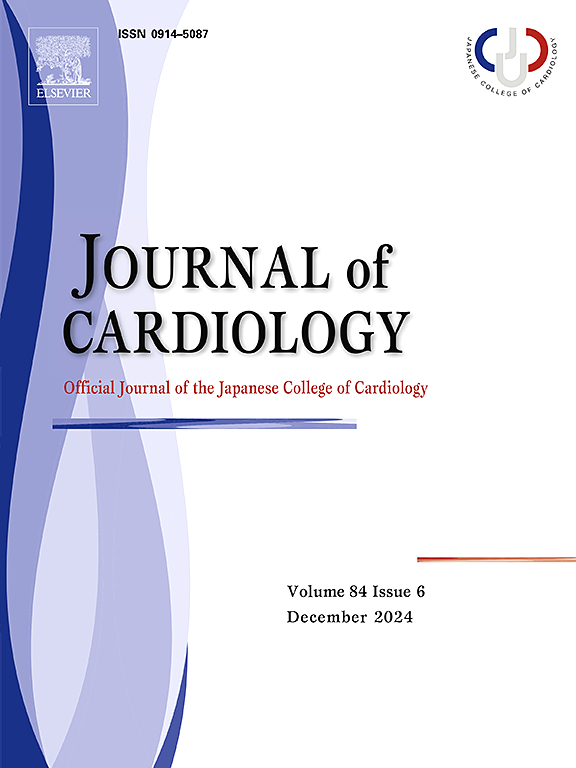An evidence-based tool for screening for heart failure with preserved ejection fraction in primary care: The BREATH2 score
IF 2.6
3区 医学
Q2 CARDIAC & CARDIOVASCULAR SYSTEMS
引用次数: 0
Abstract
Background
Heart failure with preserved ejection fraction (HFpEF) remains underdiagnosed in primary care settings, where echocardiography is not available. This study aimed to develop and validate a scoring system that does not include echocardiographic variables for HFpEF screening among patients with shortness of breath.
Methods
A total of 622 consecutive patients referred for exercise stress echocardiography were evaluated (283 HFpEF and 339 controls). Diagnosis of HFpEF was determined by the HFA-PEFF algorithm Steps 2–3.
Results
Multivariable logistic regression analysis identified age ≥65 years, coronary artery disease, elevated natriuretic peptide levels, anemia, cardiomegaly on chest radiography, and left ventricular high-voltage on electrocardiogram as independent predictors of having HFpEF. A weighted score, including the six predictors and atrial fibrillation, was created (BREATH2 score). The BREATH2 score accurately discriminated HFpEF from controls [area under the curve (AUC) 0.84, p < 0.0001], with a superior diagnostic ability to the H2FPEF score. The diagnostic accuracy was confirmed in an external validation cohort (n = 105, AUC 0.78, p < 0.0001) and in patients whose diagnosis was determined by exercise right heart catheterization (n = 79, AUC 0.75, p = 0.0001). The BREATH2 score classified each patient into different risk categories of having HFpEF, ranging from 4 % to 93 %.
Conclusions
The BREATH2 score can be an effective screening tool in primary care settings to help refer patients to a secondary hospital for further evaluation.

初级保健中保留射血分数筛选心力衰竭的循证工具:BREATH2评分。
背景:保留射血分数的心力衰竭(HFpEF)在没有超声心动图的初级保健机构中仍未得到充分诊断。本研究旨在开发和验证一种评分系统,该系统不包括超声心动图变量,用于呼吸短促患者的HFpEF筛查。方法:对622例连续接受运动应激超声心动图检查的患者(283例HFpEF和339例对照)进行评估。通过HFA-PEFF算法步骤2-3确定HFpEF的诊断。结果:多变量logistic回归分析确定年龄 ≥ 65 岁、冠状动脉疾病、利钠肽水平升高、贫血、胸片上的心脏肥大和心电图上的左室高电压是HFpEF的独立预测因素。创建一个加权评分,包括6个预测因子和房颤(BREATH2评分)。BREATH2评分准确区分了HFpEF和对照组[曲线下面积(AUC) 0.84, p 2FPEF评分。外部验证队列(n = 105,AUC 0.78, p 2评分)证实了诊断的准确性,将每个患者分为不同的HFpEF风险类别,范围为4 %至93 %。结论:在初级保健机构中,BREATH2评分可以作为一种有效的筛查工具,帮助患者转诊到二级医院进行进一步评估。
本文章由计算机程序翻译,如有差异,请以英文原文为准。
求助全文
约1分钟内获得全文
求助全文
来源期刊

Journal of cardiology
CARDIAC & CARDIOVASCULAR SYSTEMS-
CiteScore
4.90
自引率
8.00%
发文量
202
审稿时长
29 days
期刊介绍:
The official journal of the Japanese College of Cardiology is an international, English language, peer-reviewed journal publishing the latest findings in cardiovascular medicine. Journal of Cardiology (JC) aims to publish the highest-quality material covering original basic and clinical research on all aspects of cardiovascular disease. Topics covered include ischemic heart disease, cardiomyopathy, valvular heart disease, vascular disease, hypertension, arrhythmia, congenital heart disease, pharmacological and non-pharmacological treatment, new diagnostic techniques, and cardiovascular imaging. JC also publishes a selection of review articles, clinical trials, short communications, and important messages and letters to the editor.
 求助内容:
求助内容: 应助结果提醒方式:
应助结果提醒方式:


